|
|
 |
Fiche d'espèce de Copépode |
|
|
Calanoida ( Ordre ) |
|
|
|
Eucalanoidea ( Superfamille ) |
|
|
|
Eucalanidae ( Famille ) |
|
|
|
Subeucalanus ( Genre ) |
|
|
| |
Subeucalanus crassus (Giesbrecht, 1888) (F,M) | |
| | | | | | | Syn.: | Eucalanus crassus Giesbrecht, 1888; 1892 (p.132, 151, 772, figs.F,M); Giesbrecht & Schmeil, 1898 (p.22, Rem.); Thompson & Scott, 1903 (p.233, 242); Cleve, 1904 a (p.189); Esterly, 1905 (p.134, figs.F); Pearson, 1906 (p.7, Rem.); Carl, 1907 (p.16); Farran, 1908 b (p.22); A. Scott, 1909 (p.19); Sewell, 1912 (p.353, 357: Rem.F,M); 1914 a (p.202); With, 1915 (p.53, figs.F); Pesta, 1920 (p.498); Sars, 1925 (p.22); Rose, 1925 (p.151); Farran, 1926 (p.231); Sewell, 1929 (p.50); Farran, 1929 (p.207, 220); Dakin & Colefax, 1933 (p.204); Rose, 1933 a (p.68, figs.F,M); Tanaka, 1935 (p.149, figs.F,M); Farran, 1936 a (p.78); Mori, 1937 (1964) (p.23, figs.F,M); Dakin & Colefax, 1940 (p.96, figs.F,M); Wilson, 1942 a (p.184); Massuti Alzamora, 1942 (p.110); Lysholm & al., 1945 (p.9); Oliveira, 1945 (p.191); Vervoort, 1946 (p.112, Rem.); Sewell, 1947 (p.46); C.B. Wilson, 1950 (p.208); Krishnaswamy, 1953 (p.111); Rose, 1956 (p.459); Tanaka, 1956 (p.269); Kott, 1957 (p.6, 9, 16); Yamazi, 1958 (p.147, Rem.); Marques, 1959 (p.206); Ganapati & Shanthakumari, 1962 (p.7, 15); Brodsky, 1962 c (p.107, figs.F,M); Fagetti, 1962 (p.9); Grice & Hart, 1962 (p.287, table 3); Vervoort, 1963 b (p.91, figs.M, Rem.); Ahlstrom & Thrailkill, 1963 (p.57, Table 5, abundance); Giron-Reguer, 1963 (p.27); Unterüberbacher, 1964 (p.15, Rem ); De Decker & Mombeck, 1964 (p.12); Chen & Zhang, 1965 (p.35, figs.F,M); Furuhashi, 1966 a (p.295, vertical distribution vs mixing Oyashio/Kuroshio region, Table 10); Neto & Paiva, 1966 (p.19, Table III); Mazza, 1966 (p.69); 1967 (p.70, figs.juv., F,M, p.321, fig.64); Saraswathy, 1966 (1967) (p.75); Grice & Hulsemann, 1967 (p.13); Fleminger, 1967 a (tabl.1); Owre & Foyo, 1967 (p.36, figs.F,M); Marques, 1968 a (p.396); Delalo, 1968 (p.137); Koga, 1968 (p.17, fig.: egg); Itoh, 1970 a (p.: tab.1); Corral Estrada, 1970 (p.75, figs.F,M); Casanova, 1970 (p.30, fig.2); Deevey, 1971 (p.224); Binet & al., 1972 (p.71); Roe, 1972 (p.277, tabl.1, tabl.2); Lefèvre-Lehoërff, 1972 (p.1681); Kos, 1972 (Vol.I, figs.F, M, Rem.); Björnberg, 1972 (p.11, figs. Rem.N); Bainbridge, 1972 (p.61, Appendix Table II, vertical distribution %); Apostolopoulou, 1972 (p.327, 334); Fleminger, 1973 (p.978, 979, 983, 999, fig.F); Björnberg, 1973 (p.298, 386); Harding, 1974 (p.141, tab. 3, gut contents); Corral Estrada & Pereiro Muñoz, 1974 (tab.I); Nival & al., 1974 (p.231, respiration & excretion); Patel, 1975 (p.659); Vives & al., 1975 (tab.II, III, IV); Marques, 1976 (p.987); Greenwood, 1976 (p.11, figs.F); Sale P.F. & al., 1976 (p.59, table 3); Deevey & Brooks, 1977 (p.256, Table 2, Station "S"); Tranter, 1977 (p.596); Carter, 1977 (1978) (p.35); Binet, 1979 (p.401, fig.2); Goswami & Goswami, 1979 (p.103, figs.); Dawson & Knatz, 1980 (p.4, figs.F,M); Dessier, 1979 (p.201); Vaissière & Séguin, 1980 (p.23, tab.2); Chen Q-c, 1980 (p.795); Sreekumaran Nair & al., 1981 (p.493, fig.2 cont.); Marques, 1982 (p.752); Paffenhöfer & al., 1982 (p.193, feeding); Kovalev & Shmeleva, 1982 (p.82); Smith S.L., 1982 (p.1347, Table 5, grazing); Strickler, 1982 (Rem: p.159, behavior); Vives, 1982 (p.290); Gaudy & Boucker, 1983 (p.37, fig.1); De Decker, 1984 (p.315, 346: chart); Strickler, 1984 (p.187, feeding behavior); Scotto di Carlo & al., 1984 (1043); Guangshan & Honglin, 1984 (p.118, tab.); Sazhina, 1985 (p.32, figs.N); Brenning, 1985 a (p.24, Table 2); Longhurst, 1985 (tab.2); Greze & al., 1985 (p.9); Madhupratap & Haridas, 1986 (p.105, tab.1); Brinton & al., 1986 (p.228, Table 1); Michel & al., 1986 (p.35); 1986 a (p.75); Diouf & Diallo, 1987 (p.260); Baessa de Aguiar, 1988 (1990) (p.180, figs.F, Rem.F); Lozano Soldevilla & al., 1988 (p.57); Williams D. & al., 1988 (p.580); Hernandez-Trujillo, 1989 a (tab.1); Cervantes-Duarte & Hernandez-Trujillo, 1989 (tab.3); Hirakawa & al., 1990 (tab.3); Othman & al., 1990 (p.561, 563, Table 1); Suarez & Gasca, 1991 (tab.2); Yoo, 1991 (tab.1); Dai & al., 1991 (tab.1); Samba Diouf, 1991 (p.103, tableau 1); Hernandez-Trujillo, 1991 (1993) (tab.I); Baessa De Aguiar, 1991 (1993) (p.106); Rosales & Sepulveda, 1992 (p.38); Suarez, 1992 (App.1); Seguin & al., 1993 (p.23, Table 2: abundance, %, p. 26: Rem.); Kim & al., 1993 (p.269); Gajbhiye & Abidi, 1993 (p.137); Hays & al., 1994 (tab.1); Shih & Young, 1995 (p.69); Southward & al., 1995 (p.127, fig.2, 9, distribution vs time); Ramaiah & al., 1996 (p.3); Siokou-Frangou, 1997 (tab.1); Go & al., 1997 (tab.1); Ramaiah & Nair, 1997 (tab.1); Park & Choi, 1997 (Appendix); Chihara & Murano, 1997 (p.789, Pl.100,101: F,M); Hure & Krsinic, 1998 (p.20, 99); Padmavati & al., 1998 (p.349); Gilabert & Moreno, 1998 (tab.1, 2); Hwang & al., 1998 (tab.II); Wong & al, 1998 (tab.2); Mauchline, 1998 (tab.8, 30); Noda & al., 1998 (p.55, Table 3, occurrence); Smith S. & al., 1998 (p.2369, Table 6, moonsoon effects); Hernandez-Trujillo, 1999 (p.284, tab.1); Dolganova & al., 1999 (p.13, tab.1); Corten, 1999 (p.191, Table 1, fig.3); Seridji & Hafferssas, 2000 (tab.1); Dalal & Goswami, 2001 (p.22, fig.2); d'Elbée, 2001 (tabl.1); Holmes, 2001 (p.40); Lo & al., 2001 (1139, tab.I); Sameoto & al., 2002 (p.12); Zerouali & Melhaoui, 2002 (p.91, Tableau I); Beaugrand & al., 2002 (p.1692); Beaugrand & al., 2002 (p.179, figs.5, 6); Vukanic, 2003 (139, tab.1); Osore & al., 2003 (p.69); Rezai & al., 2004 (p.486, tab.2, 3, abundance); Wang & Zuo, 2004 (p.1, Table 2, dominance, origin); Daly Yahia & al., 2004 (p.366, fig.4); Zenetos & al., 2005 (p.63, Rem.: p.82, casual occurrence); Rezai & al., 2005 (p.157, Table 2: spatial & temporal variations); Fernandes, 2008 (p.465, Tabl.2); Brugnano & al., 2010 (p.312, Table 3); Ferrari & Dahms, 2007 (p.34, Rem. N); Zakaria & al., 2007 (p.52, Rem.: p.58, Table 1, vs Salinity); Hidalgo & al., 2010 (p.2089, fig.4, Table 2, cluster analysis); Medellin-Mora & Navas S., 2010 (p.265, Tab. 2); Maiphae & Sa-ardrit, 2011 (p.641, Table 2); Alvarez-Fernandez & al., 2012 (p.21, Rem.: Table 1); Zaafa & al., 2014 (p.67, Table I, occurrence):
? Eucalanus oculanus Marukawa, 1921 (p.11, figs. ?juv.F, ?juv.M); Brodsky, 1950 (1967) (p.105, figs.F, M = juv.); Koppelmann & Weikert, 2007 (p.266: tab.3); Fazeli & al., 2010 (p.153, Table 1); Goetze & Ohman, 2010 (p.2117: Rem.); Naz & al., 2012 (p.61, Table 4, relative abundance); Kobari & al., 2013 (p.78, Table 2); Lidvanov & al., 2013 (p.290, Table 2, % composition)
? Eucalanus setiger Brady, 1883 (p.39, figs.F,M); Giesbrecht, 1892 (p.132); T. Scott, 1894 b (p.30); Giesbrecht & Schmeil, 1898 (p.22) | | | | Ref.: | | | Bradford-Grieve, 1994 (p.87, 88, figs.F,M, fig. 100); Bradford-Grieve & al., 1999 (p.878, 912, figs.F,M); Conway & al., 2003 (p.165, figs.F,M, Rem.); Goetze, 2003 (p.2322 & suiv.); Boxshall & Halsey, 2004 (p.117: figs.F,M); Mulyadi, 2004 (p.108, figs.F,M, Rem.);Vives & Shmeleva, 2007 (p.876, figs.F,M, Rem.); Phukham, 2008 (p.125, figs.F, M); Goetze & Ohman, 2010 (p.2110, Table 1, A1, Fig.5, molecular study, biogeography) |  issued from : J.M. Bradford-Grieve in The Marine Fauna of New Zealand: Pelagic Calanoid Copepoda. National Institute of Water and Atmospheric Research (NIWA). New Zealand Oceanographic Institute Memoir, 102, 1994. [p.89, Fig.48]. Female (from Fleminger, 1973): A, habitus (dorsal and lateral pattern of integumental organs (black point = sites occuring at 100% frequency, o = 80-99% frequency, x = 10-79% frequency, triangle are sites which are also visible in lateral view but which are assigned to dorsal sets); Female from Tasman Sea: B, habitus (dorsal); C, urosome (dorsal); D, idem (lateral left side); E, Md (mandibular palp). Male (from Fleminger, 1973): F, habitus (dorsal); G, P5
|
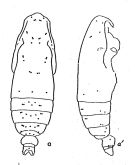 issued from : A. Fleminger in Fishery Bull. natn. Ocean. Atmos. Adm., 1973, 71 (4). [p.985, Fig.9]. As Eucalanus crassus. Female: a, habitus (dorsal), a', idem (lateral right side).
Dorsal and lateral pattern of integumental organs (black point = sites occuring at 100% frequency, o = 80-99% frequency, x = 10-79% frequency, triangle are sites which are also visible in lateral view but which are assigned to dorsal sets);
|
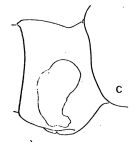 issued from : A. Fleminger in Fishery Bull. natn. Ocean. Atmos. Adm., 1973, 71 (4). [p.968, Fig.1, c (p.969)]. As Eucalanus crassus. Female: c, genital segment (lateral right side).
|
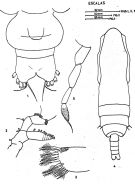 issued from : J. Corral Estrada in Tesis Doct., Univ. Madrid, A-129, Sec. Biologicas, 1970. [Lam.8]. As Eucalanus crassus. Female (from Canarias Is.): 1, urosome (ventral); 2, A2; 3, inner lobe of Mx1. Male: 4, habitus (dorsal); 5, P5.
|
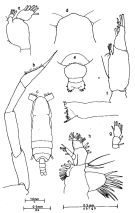 issued from : J.G. Greenwood in Proc. R. Soc. Qd, 1976, 87. [p.15, Fig.15]. As Eucalanus crassus. Female (from Moreton Bay, E Australia): d, forehead (dorsal); e, posterior metasome and urosome (dorsal); f, Md; g, endopod of P3; h, Mx2. Male: a, Md (mandibular palp); b, P5; c, habitus (dorsal).
|
 Issued from : K.A. Brodskii in Calanoida of the Far Eastern Seas and Polar Basin of the USSR. Opred. Fauna SSSR, 1950, 35 (Israel Program for Scientific Translations, Jerusalem, 1967) [p.105, Fig.31, After Marukawa, 1921] . Probably juvenil forms. Female: posterior part of thorax and urosome (dorsal. Male: habitus (dorsal); forehead (lateral); S5, P5.
|
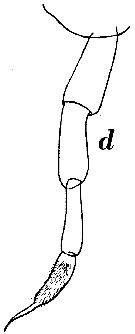 issued from : W. Vervoort in Atlantide Report., 1963, 7. [p.99, Fig.4, d]. As Eucalanus crassus. Male (from off Liberia): d, P5.
|
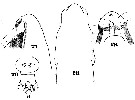 Issued from : W. Giesbrecht in Systematik und Faunistik der Pelagischen Copepoden des Golfes von Neapel und der angrenzenden Meeres-Abschnitte. – Fauna Flora Golf. Neapel, 1892. Atlas von 54 Tafeln. [Taf.35, Figs.20, 26-28]; As Eucalanus crassus. Female: 20, urosome (ventral); 26, forehead (ventral); 27, idem (lateral); 28, anterior part cephalothorax (dorsal).
|
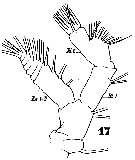 Issued from : W. Giesbrecht in Systematik und Faunistik der Pelagischen Copepoden des Golfes von Neapel und der angrenzenden Meeres-Abschnitte. – Fauna Flora Golf. Neapel, 1892. Atlas von 54 Tafeln. [Taf.11, Fig.17]; As Eucalanus crassus. Female: 17, A2 (posterior view).
|
 Issued from : W. Giesbrecht in Systematik und Faunistik der Pelagischen Copepoden des Golfes von Neapel und der angrenzenden Meeres-Abschnitte. – Fauna Flora Golf. Neapel, 1892. Atlas von 54 Tafeln. [Taf.11, Figs.15, 21]; As Eucalanus crassus. Female: 15, Md (cutting edge); 21, Md (mandibular palp)
|
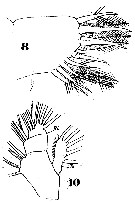 Issued from : W. Giesbrecht in Systematik und Faunistik der Pelagischen Copepoden des Golfes von Neapel und der angrenzenden Meeres-Abschnitte. – Fauna Flora Golf. Neapel, 1892. Atlas von 54 Tafeln. [Taf.11, Figs.8, 10]; As Eucalanus crassus. Female: 8, inner lobe 1 (posterior view); 10, basipod 2 of Mx1.
|
 Issued from : W. Giesbrecht in Systematik und Faunistik der Pelagischen Copepoden des Golfes von Neapel und der angrenzenden Meeres-Abschnitte. – Fauna Flora Golf. Neapel, 1892. Atlas von 54 Tafeln. [Taf.11, Figs.29, 33, 35]; As Eucalanus crassus. Female: 29, P1 (basipod 2 and endopod (anterior view); 33, P2 (posterior view); 35, P2 ( outer margin of exopod; anterior view).
|
 Issued from : W. Giesbrecht in Systematik und Faunistik der Pelagischen Copepoden des Golfes von Neapel und der angrenzenden Meeres-Abschnitte. – Fauna Flora Golf. Neapel, 1892. Atlas von 54 Tafeln. [Taf.35, Fig.4]; As Eucalanus crassus. Male: 4, habitus (dorsal).
|
 Issued from : W. Giesbrecht in Systematik und Faunistik der Pelagischen Copepoden des Golfes von Neapel und der angrenzenden Meeres-Abschnitte. – Fauna Flora Golf. Neapel, 1892. Atlas von 54 Tafeln. [Taf.11, Fig.22]; As Eucalanus crassus. Male: 22, Md (mandibular palp).
|
 Issued from : W. Giesbrecht in Systematik und Faunistik der Pelagischen Copepoden des Golfes von Neapel und der angrenzenden Meeres-Abschnitte. – Fauna Flora Golf. Neapel, 1892. Atlas von 54 Tafeln. [Taf.11, Fig.38]; As Eucalanus crassus. Male: 38, P5.
|
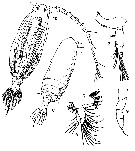 issued from : T. Mori in The pelagic Copepoda from the neighbouring waters of Japan, 1937 (2nd edit., 1964). [Pl.9, Figs.7-11]. As Eucalanus crassus. Female: 7, Md; 10, habitus (dorsal). Nota: Body hairy. Genital segment much broader than its length, and onion-shaped, between it and the anal segment with 1 segment. Anal segment fused with the caudal rami. left 2nd terminal seta of the caudal ramus is slightly longer than that of the right. The proximal 2 segments of the exopodite of A2 fused; 1st segment of endopodite is about 2 times as long as its broad, and shorter than the 2nd. Endopodite of Md reaches the distal margin of the 2nd segment of basipodite; 12st segment of endopodite with 2 setae, and the 2nd with 4 setae. 2nd lobe of Mx1 absent; 3rd lobe with 3 setae; 2nd segment of basipodite with 5 inner marginal setae. Male (Juvenile): 8, Mx1; 9, left P5; 11, habitus (dorsal). Nota: The right leg of P5 is absent. Body length about 3 mm.
|
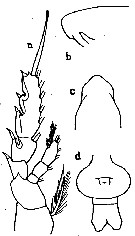 issued from : C.O. Esterly in Univ. Calif. Publs Zool., 1905, 2 (4). [p.134, Fig.8]. As Eucalanus crassus. Female (from San Diego region): a, P4; b-c, forehead (lateral and dorsal, respectively); d, urosome (ventral).
|
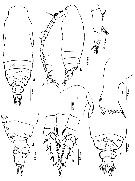 issued from : N. Phukham in Species diversity of calanoid copepods in Thai waters, Andaman Sea (Master of Science, Univ. Bangkok). 2008. [p.207, Fig.81]. Female (from W Malay Peninsula): a-b, habitus (dorsal and lateral, respectively); c, Md (mandibular palp); d, g, urosome (lateral and dorsal, respectively); e, forehead (lateral); f, Md (gnathobase); h, P2. Body length after drawing: F = 2.969 mm.
|
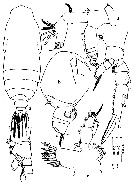 issued from : Mulyadi in Published by Res. Center Biol., Indonesia Inst. Sci. Bogor, 2004. [p.109, Fig.60]. Female (from Indonesian Seas): a, habitus (dorsal); b, forehead (lateral); c, last thoracic segments and urosome (lateral right side); d, A2; e, Mx1; f, P1 (exopod incomplete); g, P2. Nota: A2 first 2 segments of exopod fused; endopod segment 1 shorter than endopod segment 2, about twice length of wide. Endopod of Md reaches distal end of basis, endopod segment 1 with 2 setae, endopod segment 2 with 4 setae. 2nd lobe on inner margin of Mx2 absent, 3rd lobe with 3 setae, basis with 4 setae. Segments 1 and 2 of endopod of Mxp with 3 setae. Urosome segment 1 onion-shape, much wider than long; urosme segment 2 short. Caudal rami and its 2nd seta slightly asymmetrical.
|
 issued from : Mulyadi in Published by Res. Center Biol., Indonesia Inst. Sci. Bogor, 2004. [p.110, Fig.61]. Male: a, habitus (dorsal); b, cephalon (lateral); c, last thoracic segment with P5 and urosome (lateral right side); d, same (dorsal); e, cephalon (ventral); f, A2; g, Md (palp); h, P2 (endopod missing); i, P5. Nota: Urosome symmetrical, 4-segmented. Right leg of P5 absent; left leg 4-segmented, distal segment ending in long and curved spine.
|
 Issued from : M.C. Kos in Field guide for plankton. Zool Institute USSR Acad., Vol. I, 1972. After Brodsky, 1962. Female: 1-2, habitus (dorsal and lateral, respectively); 3, forehead with rostrum (lateral); 4, abdomen (dorsal); 5, Md. 6, habitus (dorsal); 7, Md; 8, left P5.
| | | | | Ref. compl.: | | | Madhupratap & Haridas, 1990 (p.305, fig.6: vertical distribution night/day; fig.7: cluster); Hsieh & Chiu, 1998 (tab.2); Suarez-Morales & Gasca, 1998 a (p.109); Lo & al., 2001 (1139, tab.I); Weikert & al., 2001 (p.227, tab.4, Rem.); Hernandez-Trujillo & Suarez-Morales, 2002 (p.748, tab.1); Hwang & al., 2003 (p.193, tab.2); Bode & al., 2003 (p.85, Table 1, abundance); Hsiao al., 2004 (p.325, tab.1); Hsieh & al. 2004 (p.397, tab. 1); Lan & al., 2004 (p.332, tab.1); Lo & al.*, 2004 (p.218, fig.6); Lo & al., 2004 (p.89, tab.1); CPR, 2004 (p.62, fig.186); Kazmi, 2004 (p.229); Zuo & al., 2006 (p.159, tab.1, abundance, fig.8: stations group); Prusova & Smith, 2005 (p.76); Lavaniegos & Jiménez-Pérez, 2006 (Tab.2, 4, Rem.); Hwang & al., 2006 (p.943, tabl. I); Hwang & al., 2007 (p.24); Dur & al., 2007 (p.197, Table IV); Valdés & al., 2007 (p.103: tab.1); Khelifi-Touhami & al., 2007 (p.327, Table 1); Jitlang & al., 2008 (p.65, Table 1); McKinnon & al., 2008 (p.844: Tab.I, p.848: Tab. IV); Ayon & al., 2008 (p.238, Table 4: Peruvian samples); Lan Y.C. & al., 2008 (p.61, Table 1, % vs stations); Tseng L.-C. & al., 2008 (p.153, Table 2, occurrence vs geographic distribution); C.-Y. Lee & al., 2009 (p.151, Tab.2); Lan Y.-C. & al., 2009 (p.1, Table 2, % vs hydrogaphic conditions); Escribano & al., 2009 (p.1083, Table 1, figs.6, 7, 10); C.E. Morales & al., 2010 (p.158, Table 1); Eloire & al., 2010 (p.657, Table II, temporal variability); Cornils & al., 2010 (p.2076, Table 3); Zenetos & al., 2010 (p.397); Mazzocchi & Di Capua, 2010 (p.425); Medellin-Mora & Navas S., 2010 (p.265, Tab. 2); W.-B. Chang & al., 2010 (p.735, Table 2, abundance); Tutasi & al., 2011 (p.791, Table 1, 3, fig.8, abundance distribution vs La Niña event, Rem. p.797, fig.11); Kâ & Hwang, 2011 (p.155, Table 3: occurrence %); Hsiao S.H. & al., 2011 (p.475, Appendix I); Hsiao & al., 2011 (p.317, Table 2, indicator of seasonal change); Tseng L.-C. & al., 2011 (p.47, Table 2, occurrences vs mesh sizes); Guo & al., 2011 (p.567, table 2, indicator); Uysal & Shmeleva, 2012 (p.909, Table I); Salah S. & al., 2012 (p.155, Tableau 1); Tseng & al., 2012 (p.621, Table 3: abundance); Teuber & al., 2013 (p.28, Table 1, respiration rates); Tachibana & al., 2013 (p.545, Table 1, seasonal change 2006-2008); Tseng & al., 2013 (p.507, seasonal abundance); Rakhesh & al., 2013 (p.7, Table 1, abundance vs stations); Jagadeesan & al., 2013 (p.27, Table 3, 5, fig.11, seasonal variation); Anjusha & al., 2013 (p.40, Table 3, abundance & feeding behavior); Hwang & al., 2014 (p.43, Appendix A: seasonal abundance); Bonecker & a., 2014 (p.445, Table II: frequency, horizontal & vertical distributions); Dias & al., 2015 (p.483, Table 2, abundance, biomass, production); Zakaria & al., 2016 (p.1, Table 1, 3); Benedetti & al., 2016 (p.159, Table I, fig.1, functional characters); Marques-Rojas & Zoppi de Roa, 2017 (p.495, Table 1); Atique & al., 2017 (p.1, Table 1); El Arraj & al., 2017 (p.272, table 1, 2); Benedetti & al., 2018 (p.1, Fig.2: ecological functional group); Belmonte, 2018 (p.273, Table I: Italian zones); Chaouadi & Hafferssas, 2018 (p.913, Table II: occurrence); Hirai & al., 2020 (p.1, Fig. 5: cluster analysis (OTU), spatial distribution). | | | | NZ: | 18 | | |
|
Carte de distribution de Subeucalanus crassus par zones géographiques
|
| | | | | | | | | | | |  Issued from : E. Goetze & M.D. Ohman in Deep-Sea Res. II, 2010, 57. [p.2117, Fig.5]. Issued from : E. Goetze & M.D. Ohman in Deep-Sea Res. II, 2010, 57. [p.2117, Fig.5].
Biogeographic distribution records for Subeucalanus crassus (Atl) and Subeucalanus crassus (Pac), two distinct genetic lineages within the nominal species Subeucalanus crassus s.l. .
Subeucalanus crassus was decribed by Fleminger (1973) as a subtropical-tropical, circumglobal species in eutrophic or broadly neritic waters.
Current sampling of new genetic lineages is inadequate the geographic distribution of these distinct taxa.
Solid and open circles mark sampling locations of specimens whose species identity was verified to be S. crassus (Atl) or S. crassus (Pac), respectively, by DNA sequencing of 165 rRNA.
Note: The 'positive" records plotted from Lang (1965) are a subset of her original material. |
 Issued from : A.J. Southward, S.J. Hawkins & M.T. Burrows in J. therm. Biol., 1995, 20 (1/2). [p.140, Fig.9].Changes in geographical distribution of the warm water copepod Eucalanus (= Subeucalanus) crassus (C & D). Issued from : A.J. Southward, S.J. Hawkins & M.T. Burrows in J. therm. Biol., 1995, 20 (1/2). [p.140, Fig.9].Changes in geographical distribution of the warm water copepod Eucalanus (= Subeucalanus) crassus (C & D).
Contours at 1, 10 and 100 individuals per 750 m3.
Nota: The figure gives an example of a latitudinal retreat of one of the warm water species between 1969 and 1979, by comparison with a cold water species as the trachymedusan Aglantha digitalis during the same period, both based on extensive sampling over the entrance of the English Channel and approaches (A. Southward, unpublish. data). The warm water species had retreated south and the cold water plankton had moved into the northern side of the western Channel to replace it. |
 Issued from : P. Tutasi, S. Palma & M. Caceres in Scienc. Mar., 2011, 75 (4). [p. 798, Fig.8 a] Issued from : P. Tutasi, S. Palma & M. Caceres in Scienc. Mar., 2011, 75 (4). [p. 798, Fig.8 a]
Geographic distribution of Subeucalanus crassus in September and October 2001, associated with the weak La Niña event of 2001. |
 Issued from : M. Madhupratap & P. Haridas in J. Plankton Res., 12 (2). [p.313, Fig.6]. Issued from : M. Madhupratap & P. Haridas in J. Plankton Res., 12 (2). [p.313, Fig.6].
Vertical distribution of calanoid copepod (mean +1 SE), abundance No/100 m3. 57- Subeucalanus crassus.
Night: shaded, day: unshaded.
Samples collected from 6 stations located off Cochin (India), SE Arabian Sea, November 1983, with a Multiple Closing Plankton Net (mesh aperture 300 µm), in vertical hauls at 4 depth intervalls (0-200, 200-400, 400-600, 600-1000 m). |
| | | | Loc: | | | South Africa (E & W), Namibia, Angola, Baia Farta, Congo, off E Sao Tomé Is., off Lagos, Ivorian shelf, Casamance, Dakar, off S Cape Verde Is., Cape Verde Is., off Morocco-Mauritania, Cap Ghir (Morocco), Canary Is., off Madeira, Portugal, off E Azores, Coruña, Bay of Biscay, Brazil, off Rio de Janeiro, Campos basin, Caeté Estuary), Barbados Is., Caribbean Colombia, Bahia de Mochima (Venezuela), Yucatan (Ascension Bay), G. of Mexico, Florida, Sargasso Sea, off Bermuda (Station "S" (32°10'N, 64°30'W), off E Cape Cod, G. of St. Lawrence, off E Nova Scotia, W Ireland, off SW Ireland, W English, off W Tangier, Medit. (Habibas Is., Sidi Fredj coast, Ligurian Sea, Tyrrhenian Sea, Ionian Sea), N-S Adriatic Sea, W Egyptian coast, Alexandria, Lebanon Basin), Red Sea, Gulf of Oman, G. of Aden, Arabian Sea, Karachi coast, Somalia, Madagascar, Rodrigues Is., Sri Lanka, India (Saurashtra coast, W, Bombay, Madras, Burhabalanga estuary, Lawson's Bay, Madras, Gulf of Mannar, Godavari region, Bay of Bengal, Nicobar Is., S Burma, W Malay Peninsula (Andaman Sea), Australia (W, North West Cape), Straits of Malacca, Indonesia-Malaysia, Ambon Bay, Flores Sea, S Celebes Sea (Manado Bay), Philippines, Viet-Nam (Cauda Bay), Hong Kong, China Seas (Yellow Sea, East China Sea, South China Sea, Xiamen Harbour), Taiwan Strait, Taiwan (S, E, SW, W, NW, N, NE, Mienhua Canyon), Okinawa, S Korea, Japan Sea, Japan, Kuchinoerabu Is., Tokyo Bay, Kuroshio region, Bikini Is., Aleutian Is., California, W Baja California, Gulf of California, off W Guatemala, Pacif. (W equatorial), Australia (G. of Carpentaria, SE, Great Barrier, Moreton Bay), New Zealand, Hawaï, off Galapagos, Ecuador, off Peru, Chile ( N, off Valparaiso, Concepcion) | | | | N: | 287 | | | | Lg.: | | | (7) F: 4-3,7; (14) F: 3,85-3,3; M: 3,25-3,1; (28) F: 3,6-2,65; M: 2,9-2,88; (35) F: 3,48-2,8; M: 3,1-2,9; (38) F: 3,6-3,4; M: 3,5-3,4; (47) F: 3,3-2,9; M: 2,9; (54) F: 3,32-2,46; M: 2,4; (91) F: 3-3,7; (104) F: 4,6; M: 2,6; (125) F: 3,73-3,17; M: 3,49-3,13; (142) F: 3; (150) F: 3,55-3,1; M: 3,15; (180) F: 2,1-2,95; (196) F: 3,9 [8,9 !]-3,05; (199) F: 3,34-2,74; M: 2,89; (207) F: 3,38-3,19; M: 2,93-2,9; (290) F: 3,25-3,7; M: 3,25-3,4; (332) F: 3,1-2,59; M: 3,14-2,78; (333) F: 3,42-3,2; M: 3,08-2,91; (432) F: 3,45-3,1; (449) F: 3,3-2,9; M: 2,9; (530) F: 3; M: 2,5; (795) F: 3; M: 2,5; (991) F: 2,46-3,7; M: 2,4-3,1; (1122) F: 3,25-3,3; M: 2,61; (1230) F: 2,6-3,6; M: 2,8-3,2; {F: 2,10-4,60; M: 2,40-3,50} | | | | Rem.: | épipélagique, parfois mésopélagique.
Voir aussi les remarques en anglais | | | Dernière mise à jour : 19/06/2023 | |
|
|
 Toute utilisation de ce site pour une publication sera mentionnée avec la référence suivante : Toute utilisation de ce site pour une publication sera mentionnée avec la référence suivante :
Razouls C., Desreumaux N., Kouwenberg J. et de Bovée F., 2005-2026. - Biodiversité des Copépodes planctoniques marins (morphologie, répartition géographique et données biologiques). Sorbonne Université, CNRS. Disponible sur http://copepodes.obs-banyuls.fr [Accédé le 08 janvier 2026] © copyright 2005-2026 Sorbonne Université, CNRS
|
|
 |
 |


























